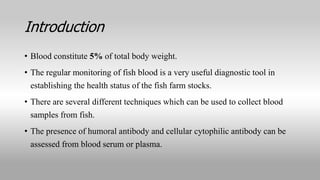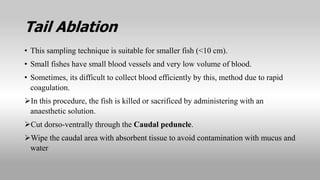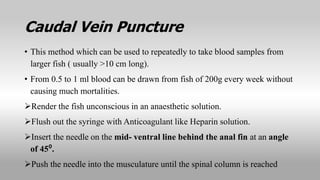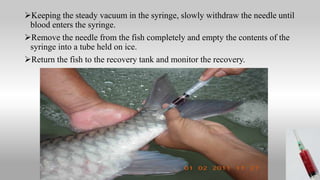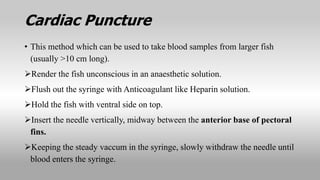Collection of fish blood
- 1. Collection of Fish Blood Submitted by Submitted to B.Naveen Rajeshwar Dr TJ Abraham Dept of AAH Dept of AAH
- 2. Introduction âĒ Blood constitute 5% of total body weight. âĒ The regular monitoring of fish blood is a very useful diagnostic tool in establishing the health status of the fish farm stocks. âĒ There are several different techniques which can be used to collect blood samples from fish. âĒ The presence of humoral antibody and cellular cytophilic antibody can be assessed from blood serum or plasma.
- 3. Different methods of Blood Collection ïķ Tail ablation of euthanized fish ïķ Caudal vein Puncture ïķ Cardiac Puncture ïķ Dorsal Aorta Puncture
- 4. Equipment's Required âĒ Fish âĒ Anaesthetising agent (MS 222) âĒ Sterile needle âĒ Syringe or vacutainer tube âĒ Dip net âĒ Gloves âĒ Thermometer âĒ Soft sponge or mat âĒ Disinfectant âĒ Sterile knife for tail ablation âĒ Empty tubes
- 5. Tail Ablation âĒ This sampling technique is suitable for smaller fish (<10 cm). âĒ Small fishes have small blood vessels and very low volume of blood. âĒ Sometimes, its difficult to collect blood efficiently by this, method due to rapid coagulation. ïIn this procedure, the fish is killed or sacrificed by administering with an anaesthetic solution. ïCut dorso-ventrally through the Caudal peduncle. ïWipe the caudal area with absorbent tissue to avoid contamination with mucus and water
- 6. ïPlace the heparinised collection tube or capillary tube at the end of caudal vessel which you have just cut. ïIn case of capillary tube allow the tube to fill by means of capillary action.
- 7. Caudal Vein Puncture âĒ This method which can be used to repeatedly to take blood samples from larger fish ( usually >10 cm long). âĒ From 0.5 to 1 ml blood can be drawn from fish of 200g every week without causing much mortalities. ïRender the fish unconscious in an anaesthetic solution. ïFlush out the syringe with Anticoagulant like Heparin solution. ïInsert the needle on the mid- ventral line behind the anal fin at an angle of 45â°. ïPush the needle into the musculature until the spinal column is reached
- 8. ïKeeping the steady vacuum in the syringe, slowly withdraw the needle until blood enters the syringe. ïRemove the needle from the fish completely and empty the contents of the syringe into a tube held on ice. ïReturn the fish to the recovery tank and monitor the recovery.
- 9. Cardiac Puncture âĒ This method which can be used to take blood samples from larger fish (usually >10 cm long). ïRender the fish unconscious in an anaesthetic solution. ïFlush out the syringe with Anticoagulant like Heparin solution. ïHold the fish with ventral side on top. ïInsert the needle vertically, midway between the anterior base of pectoral fins. ïKeeping the steady vaccum in the syringe, slowly withdraw the needle until blood enters the syringe.
- 10. ïSlowly remove the needle from the fish completely. ïRemove the needle and empty the contents of the syringe into a tube held on ice.
- 11. Dorsal Aorta Puncture âĒ This method which can be used to repeatedly to take blood samples from larger fish ( usually >10 cm long). ïRender the fish unconscious in an anaesthetic solution. ïFlush out the syringe with Anticoagulant like Heparin solution. ïThe needle is inserted midway between posterior base of anal fin and the beginning of the caudal fin. ïWhen the needle is stopped by the backbone, the aorta will be penetrated and the blood will flow into the syringes.
- 12. ïSlowly remove the needle from the fish completely. ïRemove the needle and empty the contents of the syringe into a tube held on ice
- 13. Vacutioner tubes- Types âĒ Red Top- No additives. Used for serum collection. âĒ Green Top- Anticoagulant Heparin. Used for plasma collection. âĒ Purple Top- Anticoagulant EDTA. Used for Haematology purposes. âĒ Grey Top- Additive Sodium Fluoride. Used for Glucose measurements. âĒ Light Blue top- Additive Sodium Citrate. Used for Coagulation Studies


